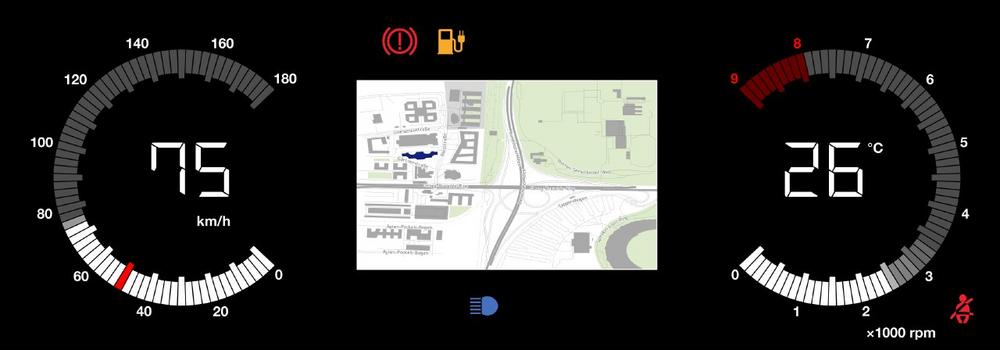The amount of information that needs to be shown on instrumental cluster displays is increasing as vehicles gain additional features and functions. On the other hand, larger displays with higher definitions increase costs. For this reason, there has been an increase, especially in emerging countries, in the number of combination-type instrumental cluster displays that use TFT LCDs for things that require display flexibility and that use segment LCDs for fixed items such as indicators and icons.
The S1D15106 is a segment LCD driver that can be directly connected to a microcontroller. Image data transferred from the microcontroller can be displayed on the segment display without an external memory.1 Static driving enables high contrast, while pulse-width modulation (PWM) enables the 16-level grayscale segment display, making this driver ideal for the visualization of things such as speedometers and tachometers.2,3
Furthermore, the driver circuit is equipped with display safety functions such as segment/common output problem (open/short) detection, and if a line from driver output to display is open and a display abnormality is detected, the display can be restored by switching the driver output terminal via control from the microcontroller. The safety functions of the driver circuit support the construction of highly reliable display systems. This driver satisfies the strict quality requirements for automotive products. It is compliant with AEC-Q100 and operates at temperatures up to 105℃.4
Epson seeks to advance the frontiers of industry and drive the circular economy by applying the efficient, compact, and precision technologies that it has developed over many years to solve challenges. These technologies, which save energy, enable smaller products, and increase accuracy and precision, enable Epson to contribute to the Sustainable Development Goals (SDGs), which will bring about a better and more sustainable future for all.
Epson also seeks to leverage its device technologies to realize a smart society. Toward this end, the company will continue to develop a variety of controllers and drivers for in-vehicle display systems that require high resolution and safety functions and that enhance the performance of our customers‘ products.
Product features
- Segment: 368 outputs
Common: 1 output - Static driving for high contrast
- 16-level grayscale display enabled by PWM
- Display safety functions
1 A microcontroller, or MCU, is an integrated circuit that is primarily used in built-in systems of electronic equipment. An MCU is a type of computer that has been optimized for the control of electronic equipment.
2 Static driving is a method in which the display segment of the liquid crystal panel and the segment terminal of the liquid crystal driver are connected and driven on a one-to-one basis.
3 Pulse width modulation is a modulation method that modules pulse width (= ON time).
4 AEC-Q100: The Automotive Electronics Council (AEC) is an industry group that creates standards for the reliability and qualification of automotive electronics. It was formed by the “Big Three” U.S. automobile manufacturers in partnership with major electronic component manufacturers. The AEC standard is a de facto global standard that has been widely adopted as a standard for automotive electronic components.
About Epson
Epson is a global technology leader dedicated to co-creating sustainability and enriching communities by leveraging its efficient, compact, and precision technologies and digital technologies to connect people, things, and information. The company is focused on solving societal issues through innovations in home and office printing, commercial and industrial printing, manufacturing, visual and lifestyle. Epson will become carbon negative and eliminate use of exhaustible underground resources such as oil and metal by 2050.
Led by the Japan-based Seiko Epson Corporation, the worldwide Epson Group generates annual sales of around JPY 1 trillion.
global.epson.com/
Epson Europe Electronics GmbH is a marketing, engineering and sales company and the European headquarter for electronic devices of the Seiko Epson Corporation, Japan. Since 1989 located in Munich/Germany with 50 employees, Epson Europe Electronics GmbH has several European sales representatives and a European-wide network of distributors. Epson Europe Electronics GmbH provides value added services for timing devices, semiconductors, sensors and sensing systems targeted to various markets like industrial, automotive, medical, and communication. Epson products are recognized for energy saving, low power, small form factors and rapid time to market. More information about Epson Europe Electronics GmbH is available on the internet under www.epson-electronics.de
Epson Europe Electronics GmbH
Riesstraße 15
80992 München
Telefon: +49 (89) 14005-0
Telefax: +49 (89) 14005-110
http://www.epson-electronics.de
![]()

